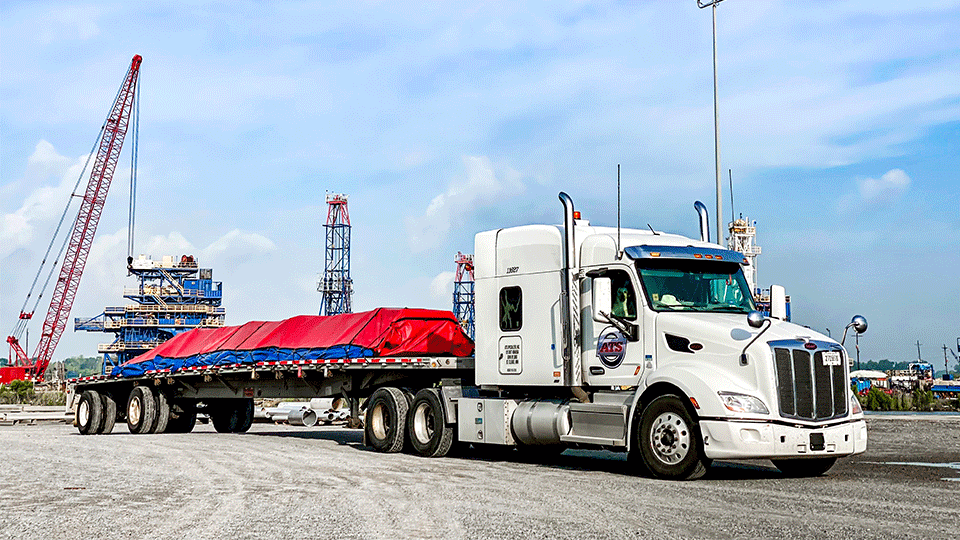 The trucking industry is reliant on its equipment. And, man, there are a ton of different equipment types. From class-8 semi trucks to 53-foot trailers, jeep/stinger dollies and 3-axle RGNs, “equipment” means everything to trucking companies.
The trucking industry is reliant on its equipment. And, man, there are a ton of different equipment types. From class-8 semi trucks to 53-foot trailers, jeep/stinger dollies and 3-axle RGNs, “equipment” means everything to trucking companies.
Equipment, in this industry, is more than these large pieces of machinery though. Straps, chains, tarps, corner protectors, dunnage, pallet jacks and coil racks are also examples of the equipment carriers use to safely transport freight.
These tools are used to load, secure, brace and protect cargo as it transits from A to B.
No shipment can move without the correct equipment. And, when an ill-equipped truck shows up at a pickup site, delays occur while a solution is sorted out.
Usually, these situations surface when communication lapses occur in conversations between a transportation provider and their customer. Make sure to share these eight load details to avoid communication issues and this problem.
To ensure successful shipments, it’s also important to have a baseline understanding of what equipment you can expect a truck driver to carry with them at a minimum.
Anderson Trucking Service (ATS) has been in the transportation industry since 1955 and today employs more than 1,500 drivers. In this article, we’ll tell you the gear and equipment most semi-trucks have on board so you can plan accordingly in the future.
What Equipment Do Open-Deck Drivers Carry?
Open-deck trucking companies are reliant on their equipment. With so many variables at play, keeping cargo safe and secure from A to B takes a well-outfitted truck.
Whether it’s a flatbed, step-deck, double drop or one of the many other open-deck trailer types, understanding the types and quantity of equipment your driver will have with them is important.
Although exact piece counts may vary slightly, as an industry standard expect your truck driver to carry the following:
- 12 straps
- 6-12 chains
- 6-12 binders
- 2 drop tarps of the same size - some drivers don’t carry tarps at all
- A fixed amount of wood dunnage (usually 4-8 pieces)
- Corner protectors (plastic v-boards, cardboard, plastic pieces, etc.)
What Equipment do Dry Van Drivers Carry?
Like open-deck drivers, dry van truckers will have a standard set of equipment with them at all times. Once again, it’s difficult to definitively say exactly what the truck driver that shows up at your door with have with them. That said, here’s the equipment most dry van drivers have on hand:
- Ratchet straps (only a few are standard)
- Load locks (1-2)
Things like load bars, dunnage and corner protectors aren’t as commonly carried and it’s impossible to give you a baseline expectation for your situation. For this reason, it’s important to connect with your transportation provider so you know exactly what your driver will have on hand.
One common misconception in the dry van transportation market is that these drives commonly have pallet jacks with them. This is not the case. In the majority of instances, you’ll need to request a driver to bring a pallet jack. Never assume they will have one upon arrival.
Additionally, liftgates are not a standard offering on dry van trailers. So, to save some money on shipments with these requirements, consider these seven alternative solutions.
How to Make Sure Your Driver Has All of the Equipment You Need
Though the equipment listed above is a great starting point, never assume your driver will have all of the equipment you need — especially if your freight requires extra attention.
Instead, ensure your shipment picks up and delivers on time by communicating properly upfront.
Proper communication between a shipper and a transportation company means listing all pertinent cargo details, providing pictures of the commodities, supplying a securement plan when possible and staying in touch with each point of contact regularly.
5 Ways to Improve Your Supply Chain Efficiency
As long as you understand the type of equipment most truck drivers carry with them, you should feel confident that your carrier’s truck will have the resources to safely haul your shipment.
Always remember: it never hurts to make sure your truck driver understands exactly what materials and equipment your freight will require.
At the end of the day, you know your freight — and its requirements — better than anyone else. Get your provider on the same page with thorough communication from the start.
Making communication a priority, regardless of the freight you ship, will help you become a more efficient company on many levels. Looking for a few additional ways to become more efficient? Here is an article listing five ways to improve your supply chain efficiency starting right now.




